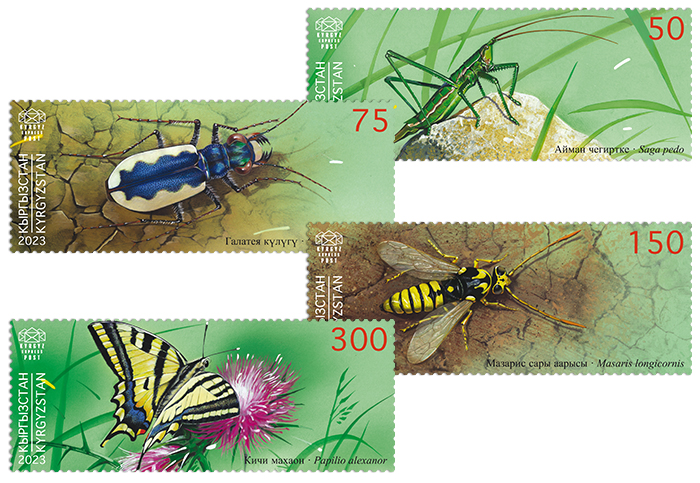
Kyrgyz Republic Red Data Book (IV). Insects
Newsletter no. 94.pdf
On April 30, 2024 the Ministry of Digital Development of the
Kyrgyz Republic puts into circulation a 2023 series of Kyrgyz Express Post postage stamps and a souvenir
sheet: "Kyrgyz Republic Red Data Book (IV). Insects".
Insects are the most numerous and diverse group of living
organisms on our planet. Scientists have described at least 1.2 million species of insects, but in fact,
according to the most conservative estimates, there are about two and a half million species – more than the
combined number of other animals, fungi and plants species. Insects contribute significantly and
multifariously to the existence and development of the entire Earth’s biosphere.
Kyrgyzstan, with its unique (predominantly mountainous)
geographical position in the southwestern part of Inner Asia at the interface of different parts of the
ancient continent, possesses a remarkable diversity of insect fauna. According to calculation conducted in
2012–2013, 14,600±30 species of insects were registered in the country, but in reality, according to some
estimates, there may be 30,000 species. The concentration of arthropod species in Kyrgyzstan is two to three
times higher than the world average. About a quarter of insect species are endemic to the Tien Shan, meaning
they are found nowhere else in the world. Some insect species are very rare and local, others have rapidly
reduced in area and numbers due to land development and now need protection and conservation. Seventeen
species of insects are listed in the Red Data Book of the Kyrgyz Republic. Five of them are featured on the
new KEP stamps.
The Matriarchal Katydid, or Predatory Bush Cricket (Saga pedo) is
a large (53-80 mm without ovipositor) wingless parthenogenetic species from the Tettigoniidae family, a
representative of the relict steppe fauna. In Kyrgyzstan, it has been recorded in the Uzun-Akhmat Gorge, on
the northern slopes of the Alexander Mountain Range and in the Chu Valley. It inhabits virgin steppe
biotopes with shrubs, and in the mountains - well-warmed slopes up to 1,400 m above sea level. Both larvae
and imagoes are ambush predators, active mainly at night. It has one generation per year, eggs are laid from
mid-summer to autumn, in small batches in the soil.
The Galatea Tiger Beetle (Cephalota galatea) is a narrow-range
species from the Ground beetles (Carabidae) family. This is a strikingly colored beetle with a
characteristic appearance for Tiger beetles (Cicindelidae), with a length of 17-20 mm. Being an endemic of
the low mountains (from 400 to 1,100 m above sea level) on the southern and northern edges of the Fergana
Valley, it is known from only a few locations. These beetles inhabit uncultivated dry open biotopes on
clayey soils. Imagoes are active diurnal predators, flying in late May and June, the larvae are still
unknown.
The Kuznetzov’s Longicorn Wasp (Masaris longicornis) is a rare
relict species from the Vespidae family, belonging to a small archaic group of Pollen Wasps (Masarinae),
which group appeared in the second half of the Cretaceous period and evolutionarily serving as the
predecessors of bees. These wasps are medium in size (10-13 mm), the females are noticeably different from
males in appearance, coloration and short antennae. They dig burrows with solitary nests in the ground,
where they collect pollen from select plants to feed the larvae. In Kyrgyzstan, these rare wasps were
registered in several mountain ranges in the woody and shrubby belts of mountains or higher, in the
subalpine meadows, at altitudes ranging from 1,800 to 3,100 m above sea level. They settle in small colonies
in dry plots of open ground or in sun-exposed cliffs.
The Southern Swallowtail (Papilio alexanor) is a large (60-70 mm
in wingspan) butterfly from the family of Swallowtails (Papilionidae), similar in appearance to the Common
swallowtail. In Kyrgyzstan, it is found (subspecies Voldemar) in the western part of the Alexander and Talas
Mountain Ranges, in Sary-Chelek, in the Ketmen-Tyube Valley and on the southern slopes of the Moldo-Too
Mountain Range, at altitudes of 800-2,200 m above sea level. The population density of this species is very
low, butterflies fly from May to July, feeding on the nectar of flowers of wild onions and the Daisy family.
The caterpillars feed on umbellifers (Parsley family) and pupate in August.
The Kirghizobia Longicorn Beetle (Kirgizobia bohnei), featured on
the souvenir sheet, is the only species in the genus that is endemic to Kyrgyzstan (as reflected in its
name). This medium-sized (17-20 mm) representative of the Longhorn beetles (Cerambycidae) family, is known
from only a few places in the mid-mountain zone in the Fergana Mountain Range and the Alai Mountain System.
They are found on the banks of large and medium-sized rivers at altitudes up to 2,300 m above sea level, in
deciduous forest with old and drying willows and poplars, under the bark of which the larvae develop.
Completely black females are known. The extreme rarity of this species is caused by the reduction of
suitable habitats.
The souvenir sheet FDC shows the Southern Swallowtail, and the FDC
with stamp series depicts the Coronate Spiketail (Sonjagaster coronata). This large (between 55 to 80 mm
long) contrasting yellow-and-black dragonfly is the only one representative of the Cordulegasteridae family
in Kyrgyz fauna. This species inhabit predominantly in western and southern parts of the country, in the
mid-mountain zone (800–2,600 m above sea level), where it sporadically inhabits gorges with streaming water
and shady trees and shrubs. The flight period lasts from late May to early August. The larvae are predators,
burrow into the sandy bottom, several times overwinter.
All red-listed species require protection, but particular concern
is raised for the Galatea Tiger Beetle and Kirghizobia Longicorn Beetle, they were assigned to threat
category I in Kyrgyzstan (the remaining 15 insect species are classified as threat categories II and III).
Humanity has already recognized the importance of preventing the loss of biodiversity, even for small and
very rare organisms, as this inevitably leads to environmental disorder, weakening of natural harmony and a
threat to the existence of life itself on the Earth. KEP hopes that the new issue of postage stamps will
contribute to the preservation of our unique nature, an inherent part of which is the fascinating world of
insects.
We would like to express our gratitude to entomologist Dmitry
Milko, Senior Scientific Fellow of the Institute of Biology, National Academy of Sciences of Kyrgyzstan, for
his valuable advice in the preparation of this issue.
For this series, KEP also issues five postcards, which are used to
realize five maximum cards.

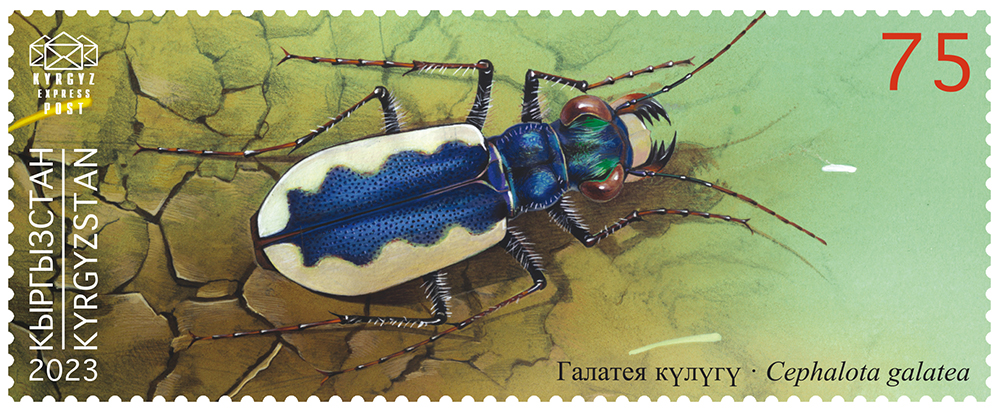


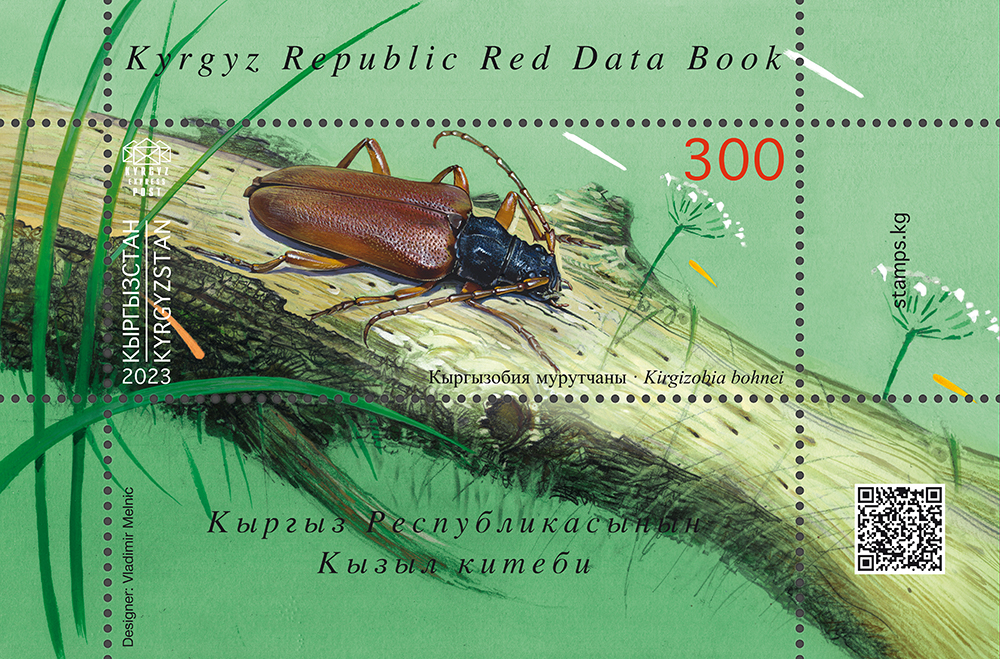
No. 214

Stamps and Souvenir sheet description
No. 210. 50 KGS. The Matriarchal Katydid, Predatory Bush Cricket (Saga pedo)No. 211. 75 KGS. The Galatea Tiger Beetle (Cephalota galatea)
No. 212. 150 KGS. The The Kuznetzov’s Longicorn Wasp (Masaris longicornis)
No. 213. 300 KGS. The Southern Swallowtail (Papilio alexanor)
Souvenir sheet no. 19
No. 214. 300 KGS. The Kirghizobia Longicorn Beetle (Kirgizobia bohnei)
Technical specifications
Paper: coated, gummed, 105 g/m².
Printing method: full-color offset lithography.
Perforation: comb 14:14½.
Designer: Vladimir Melnic.
Stamps:
Stamps size: 69 × 27.5 mm.
Stamps are issued in minisheets of 5 stamps with 1 label. Stamps are also issued in a collective minisheet of 4 stamps (1 complete set).
Minisheets size: 159 × 108 mm.
Collective minisheet size: 159 × 80.
Quantity issued: 9 000 pieces each stamp, including the quantity of the collective minisheet – 3 000 pieces.
Souvenir sheet:
Stamp size: 69 × 27.5 mm.
Souvenir sheet size: 100 × 66 mm.
Quantity issued: 3 400 souvenir sheets.
Printer House: "Nova Imprim" (Chișinău, Moldova).


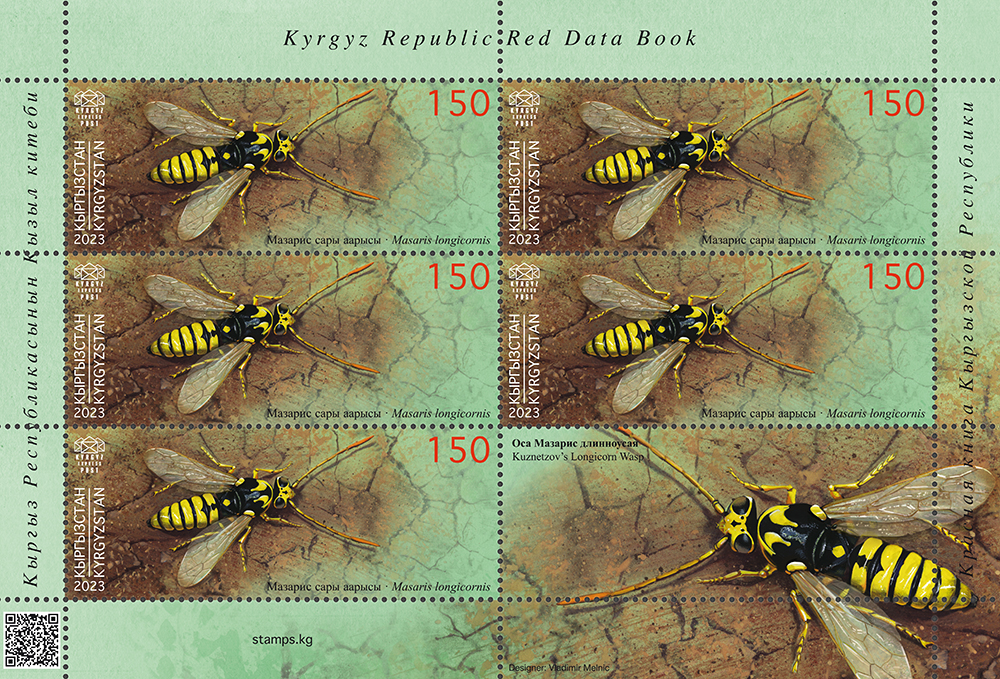

A special cancellation on FDCs will be carried out at the Bishkek KEP Office (729001) on the stamps and souvenir sheet issuing day.
The first day covers, postcards and special postmark are designed by Vladimir Melnic.
Covers size: 190 × 130 mm.
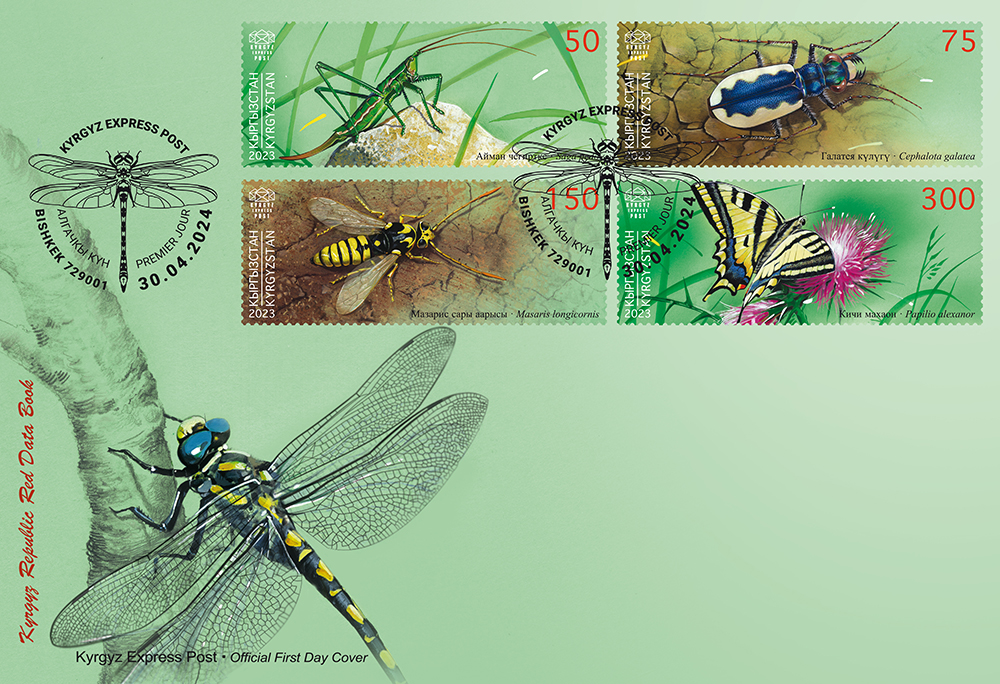
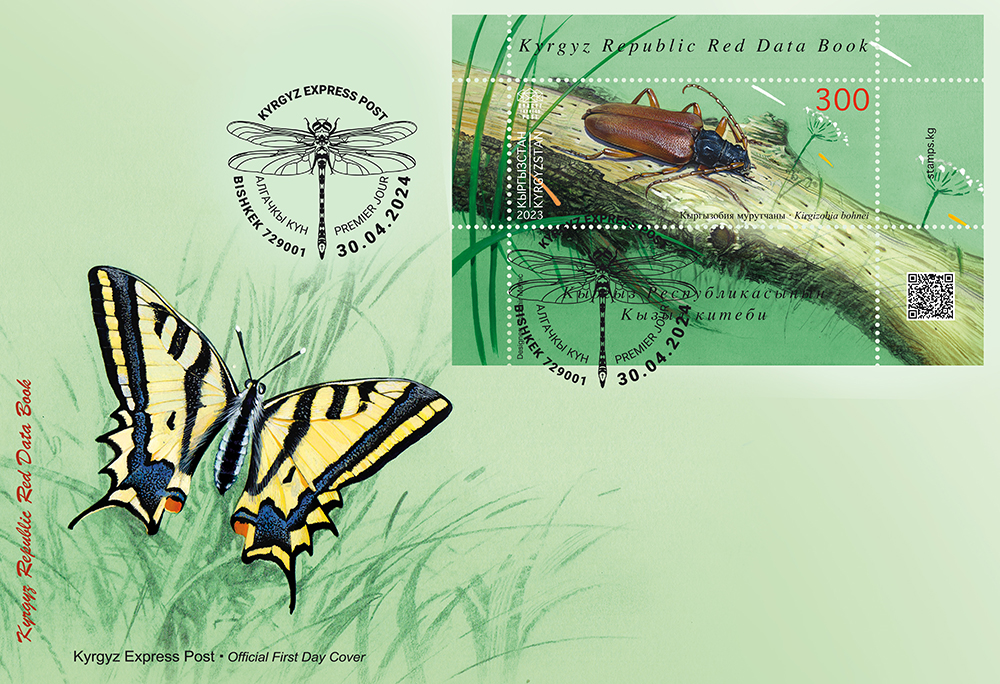
The souvenir sheet FDC shows the Southern Swallowtail, and the FDC with stamp series
depicts the Coronate Spiketail (Sonjagaster coronata).
Quantity of stamp series covers issued: 400 pieces.
Quantity of souvenir sheet covers issued: 400 pieces.
Quantity of postcards issued: 400 pieces each.
Endorsing ink color: black.




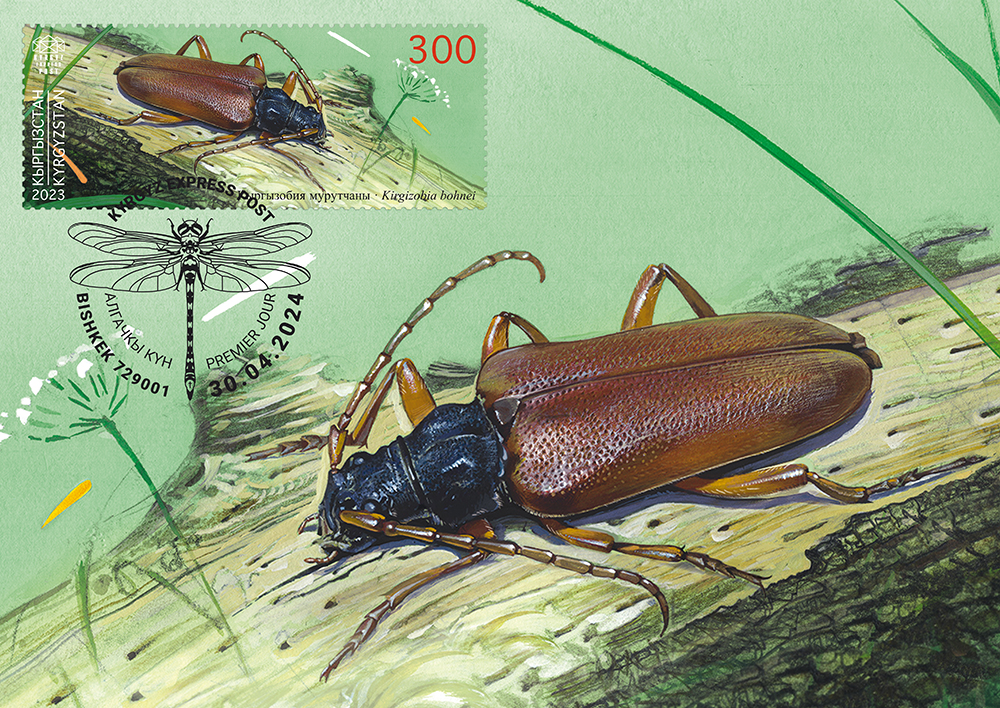
Stamps, souvenir sheet, maximum cards and FDCs can be purchased here.



